Fri, Jul 18, 2025
[Archive]
Volume 9, Issue 3 (September 2013)
IJEEE 2013, 9(3): 143-149 |
Back to browse issues page
Download citation:
BibTeX | RIS | EndNote | Medlars | ProCite | Reference Manager | RefWorks
Send citation to:



BibTeX | RIS | EndNote | Medlars | ProCite | Reference Manager | RefWorks
Send citation to:
Daghighi A. Output-Conductance Transition-Free Method for Improving Radio-Frequency Linearity of SOI MOSFET Circuits. IJEEE 2013; 9 (3) :143-149
URL: http://ijeee.iust.ac.ir/article-1-556-en.html
URL: http://ijeee.iust.ac.ir/article-1-556-en.html
Abstract: (14234 Views)
In this article, a novel concept is introduced to improve the radio frequency (RF) linearity of partially-depleted (PD) silicon-on-insulator (SOI) MOSFET circuits. The transition due to the non-zero body resistance (RBody) in output conductance of PD SOI devices leads to linearity degradation. A relation for RBody is defined to eliminate the transition and a method to obtain transition-free circuit is shown. 3-D Simulations of various body-contacted devices are carried out to extract the transition-free body resistances. To identify the output conductance transition-free concept and its application to RF circuits, a 2.4 GHz low noise amplifier (LNA) is analyzed. Mixed mode device-circuit analysis is carried out to simultaneously solve device transport equations and circuit spice models. FFT calculations are performed on the output signal to compute harmonic distortion figures. Comparing the conventional body-contacted and transition-free SOI LNAs, third harmonic distortion (HD3) and total harmonic distortion (THD) are improved by 16% and 24%, respectively.
Two-tone test is used to analyze third order intermodulation distortions. OIP3 is improved in transition-free SOI LNA by 17% comparing with the conventional body-contacted SOI LNA. These results show the possibility of application of transition-free design concept to improve linearity of RF SOI MOSFET circuits.
Type of Study: Research Paper |
Subject:
Semiconductor Devices
Received: 2013/02/20 | Revised: 2014/09/28 | Accepted: 2013/07/22
Received: 2013/02/20 | Revised: 2014/09/28 | Accepted: 2013/07/22
| Rights and permissions | |
 |
This work is licensed under a Creative Commons Attribution-NonCommercial 4.0 International License. |







